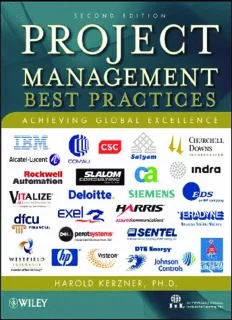
Project Management: Best Practices: Achieving Global Excellence PDF
Preview Project Management: Best Practices: Achieving Global Excellence
ffffiirrss..iinndddd iiii 1122//77//0099 44::5577::4444 PPMM P R O J E C T M A N A G E M E N T BEST PRACTICES ffffiirrss..iinndddd ii 1122//77//0099 44::5577::4444 PPMM ffffiirrss..iinndddd iiii 1122//77//0099 44::5577::4444 PPMM P R O J E C T M A N A G E M E N T BEST PRACTICES Achieving Global Excellence SECOND EDITION HAROLD KERZNER, PH. D. John Wiley & Sons, Inc. ffffiirrss..iinndddd iiiiii 1122//77//0099 44::5577::4444 PPMM This book is printed on acid-free paper. Copyright © 2010 by International Institute for Learning, Inc., New York, New York. All rights reserved. Published by John Wiley & Sons, Inc., Hoboken, New Jersey Published simultaneously in Canada No part of this publication may be reproduced, stored in a retrieval system, or transmitted in any form or by any means, electronic, mechanical, photocopying, recording, scanning, or otherwise, except as permitted under Section 107 or 108 of the 1976 United States Copyright Act, without either the prior written permission of the Publisher, or authorization through payment of the appropriate per-copy fee to the Copyright Clearance Center, Inc., 222 Rosewood Drive, Danvers, MA 01923, (978) 750-8400, fax (978) 750-4470, or on the web at www. copyright.com. Requests to the Publisher for permission should be addressed to the Permissions Department, John Wiley & Sons, Inc., 111 River Street, Hoboken, NJ 07030, (201) 748-6011, fax (201) 748-6008, or online at http://www.wiley.com/go/permission. Limit of Liability/Disclaimer of Warranty: While the publisher and author have used their best efforts in preparing this book, they make no representations or warranties with respect to the accuracy or completeness of the contents of this book and specifi cally disclaim any implied warranties of merchantability or fi tness for a particular purpose. No warranty may be created or extended by sales representatives or written sales materials. The advice and strategies contained herein may not be suitable for your situation. You should consult with a professional where appropriate. Neither the publisher nor author shall be liable for any loss of profi t or any other commercial damages, including but not limited to special, incidental, consequential, or other damages. For general information on our other products and services or for technical support, please contact our Customer Care Department within the United States at (800) 762-2974, outside the United States at (317) 572-3993 or fax (317) 572-4002. Wiley also publishes its books in a variety of electronic formats. Some content that appears in print may not be available in electronic books. For more information about Wiley products, visit our web site at www.wiley.com. “PMI,” the PMI logo, “OPM3”, “PMP”, and “PMBOK” are registered marks of Project Management Institute, Inc. For a comprehensive list of PMI marks, contact the PMI Legal Department. Library of Congress Cataloging-in-Publication Data: Kerzner, Harold. Project management : best practices : achieving global excellence / Harold Kerzner. —2nd ed. p. cm. Includes bibliographical references and index. ISBN 978-0-470-52829-7 (cloth : alk. paper) 1. Project management—Case studies. I. Title. HD69.P75K472 2010 658.4'04—dc22 2009042592 Printed in the United States of America 10 9 8 7 6 5 4 3 2 1 ffffiirrss..iinndddd iivv 1122//77//0099 44::5577::4455 PPMM To my wife, Jo Ellyn, who showed me that excellence can be achieved in marriage, family, and life as well as at work ffffiirrss..iinndddd vv 1122//77//0099 44::5577::4455 PPMM ffffiirrss..iinndddd vvii 1122//77//0099 44::5577::4455 PPMM Contents Preface xv International Institute for Learning, Inc. (IIL) xix 1 UNDERSTANDING BEST PRACTICES 1 1.0 Introduction 1 1.1 Project Management Best Practices: 1945–1960 2 1.2 Project Management Best Practices: 1960–1985 3 1.3 Project Management Best Practices: 1985–2010 6 1.4 An Executive’s View of Project Management 11 1.5 Best Practices Process 16 1.6 Step 1: Defi nition of a Best Practice 18 1.7 Step 2: Seeking Out Best Practices 23 1.8 Dashboards and Scorecards 36 1.9 Key Performance Indicators 39 1.10 Step 3: Validating the Best Practice 44 1.11 Step 4: Levels of Best Practices 46 1.12 Step 5: Management of Best Practices 48 1.13 Step 6: Revalidating Best Practices 49 1.14 Step 7: What to Do with a Best Practice 50 1.15 Step 8: Communicating Best Practices across the Company 51 1.16 Step 9: Ensuring Usage of the Best Practices 53 1.17 Common Beliefs 54 1.18 Best Practices Library 55 1.19 DTE Energy 58 1.20 A Consultant’s View of Project Management and Best Practices 60 vii ffttoocc..iinndddd vviiii 1122//77//0099 44::5588::5500 PPMM viii CONTENTS 2 FROM BEST PRACTICE TO MIGRAINE HEADACHE 67 2.0 Introduction 67 2.1 Good Intentions Becoming Migraines 67 2.2 Enterprise Project Management Methodology Migraine 68 2.3 Customer Satisfaction Migraine 69 2.4 Migraine Resulting from Responding to Changing Customer Requirements 70 2.5 Reporting Level of PMO Migraine 71 2.6 Cash Flow Dilemma Migraine 71 2.7 Scope Change Dilemma Migraine 72 2.8 Outsource or Not Migraine 73 2.9 Migraine of Determining When to Cancel a Project 73 2.10 Migraine of Providing Project Awards 74 2.11 Migraine from Having Wrong Culture in Place 75 2.12 Sources of Smaller Migraines 76 2.13 Ten Uglies of Projects 79 References 88 3 JOURNEY TO EXCELLENCE 89 3.0 Introduction 89 3.1 The Light at the End of the Tunnel 91 3.2 Managing Assumptions 94 3.3 Managing Assumptions in Conservation Projects—WWF International 95 3.4 Project Governance 99 3.5 Seven Fallacies That Delay Project Management Maturity 100 3.6 Motorola 103 3.7 Texas Instruments 104 3.8 EDS 106 3.9 Exel Corporation 108 3.10 Hewlett-Packard 118 3.11 DTE Energy 120 3.12 Comau 121 3.13 Visteon 130 3.14 Convergent Computing 138 3.15 Avalon Power and Light 140 3.16 Roadway 141 3.17 Defcon Corporation 142 3.18 Kombs Engineering 144 3.19 Williams Machine Tool Company 145 ffttoocc..iinndddd vviiiiii 1122//77//0099 44::5588::5500 PPMM
Description: